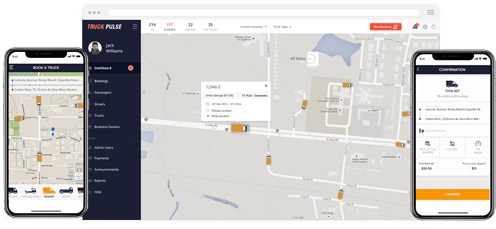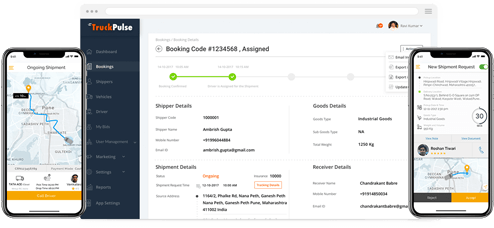Since 2006, when the FAA (Federal Aviation Administration) first issued commercial drone permits which brought about an era of new innovation in drone technology, the impact of drone delivery in the logistics has sky-rocketed. While direct delivery via drones to customers is still not commercially viable, in WMS ( Warehouse Management Systems) and YMS (Yards Management Systems) usage of UAV(Unmanned Aerial Vehicles) or drones has seen abundance progress. Nowadays drones are used not only for deliveries but also for inventory management and maintenance. Drones, when controlled in an effective manner with deep learning AI technologies, surpasses manual labor in warehouses by being vastly speedy, time-saving and cost-effective.
Modes Of Transport That Benefits From Drone Tech
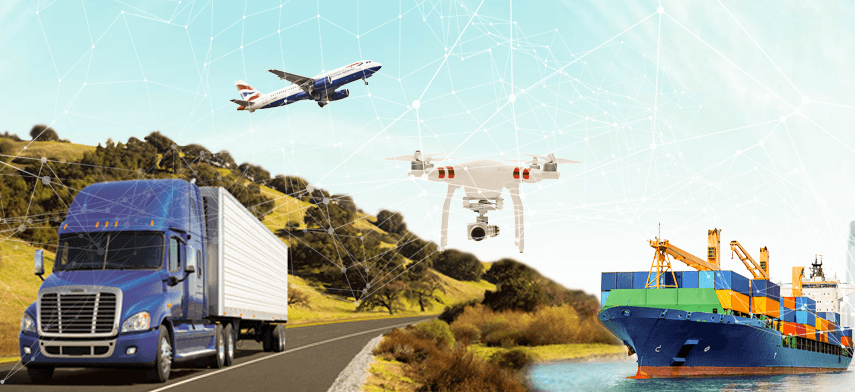
- Shipping
One of the largest methods of commercial transport has become faster because drones are being utilized for review & inspection of loading/unloading shipments. The added benefit of real-time tracking of the cargo makes ocean freight more reliable than before.
- Rail Transportation
A low-cost method for transporting large volumes like rail benefits from drone surveillance for its maintenance and tracking. Transport drones that deliver cargo after removing it from train containers as it reaches shipping locations would make this transport much faster as well.
- Road Transportation
Automation has already helped truck freight a lot in speeding up their operations, but this method of transport still suffers in dense urban areas with a lot of vehicular traffic and in remote areas where the reach of the road infrastructure is limited. Here drones can make last-mile delivery faster and more seamless.
- Air Transportation
This mode of transport is severely impacted by the commercial use of drones. Drones provide the flexibility and affordance for small package delivery that airplanes are limited due to the small number of designated ports and huge infrastructure needed to set the air freight system up.
Challenges of Implications of Drones in the Logistic Industry
While the reach of drone delivery in logistics is huge by any margin as of now, there are still challenges that the industry faces:
- Financial
Mass production of drones built to a technically specific task will be a cost-saving endeavor in the longer-term, yet for now, the manufacturing for the same is expensive for big WMS or YMS systems. Plus the maintenance of drones and its controlling devices like mobiles/tablets against the weather in open yards and rough conditions of the indoor warehouse plays a major role in keeping the operation costs of using drones in logistics higher overall.
- Privacy
As guidelines to govern the usage of drones is still at a nascent stage, companies face privacy concerns regarding their data and sensitive information associated with drone operations. With more prevalent usage of drones in the logistics industry, the government will take necessary steps to overcome this concern.
- Weight of Cargo
Drones, due to the limitations of their own size, can only carry up to 5 lbs of cargo weight at a time without compromising industry safety standards. While this is beneficial in smaller shipments for customers, it limits the usage of drones in industries with heavier shipments and cargo containers.
- Flight Height of Drones
Drones are not allowed to fly above the height of 400m, which hampers its usage in delivery in cities where there are skyscrapers or remote towns with dense tall forests. Visibility range from their controlling devices is affected in these areas too which limits a drone’s safe flying range considerably.
- Air traffic
Drones are effective in curbing land traffic because it will lighten the load of land transport, but at the same time increased use of drones has a possibility of creating congested airspace. Proper route maps for drones will have to be defined along with near field communication between drones to synchronize their movements to avoid accidents.
Benefits of Drones in the Logistics Industry
Drones are used extensively and help in making the service fast and convenient. The benefits for the industry are:
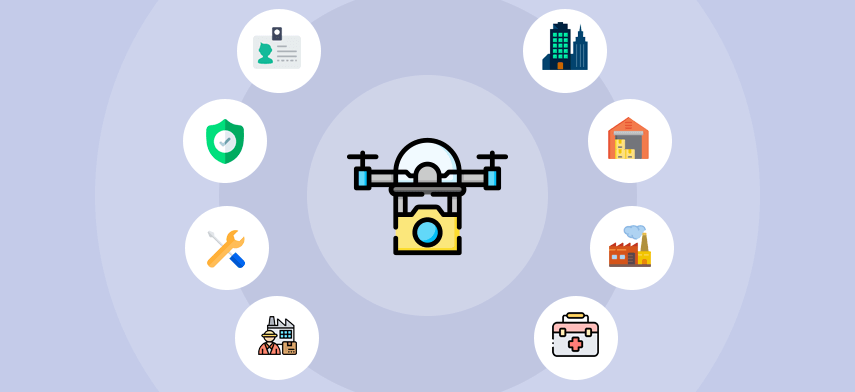
- Delivers Products
UAVs are already being utilized as small cargo delivery transport within warehouses and they prove to be faster than manual deliveries of spare parts to hard to reach spaces within the intricate machinery sprawled across factory floors. They provide these services day and night because these technologies are not tethered with human faculties in real-time.
- Enhances Time Management
Drones equipped with QR code scanners & RFID scanners are faster and consistently reliable at identifying shipping containers, machinery or manufacturing components than their human counterparts. The advantage of height gives them a benefit of reach in places where the inventory items are not directly visible from the ground. Once the process is automated from beginning to end, a conveyor belt system of identifying, sorting and storing makes any warehouse or yard management system more time-efficient than the previous manual world standards.
- Conserves Energy
In today’s digital world, drone technology along with mobile-enabled applications, inventory identification can quickly and seamlessly be completed by one operator as opposed to a huge chain of manual inventory management employees. This applied on a large scale, drone improves the management system while using a fraction of resources. This conserves energy globally.
- Saves Time
Studies have shown that Two fully autonomous drones can do the job of 100 humans in an hour, 100 times more accurate. Multiply that across many warehouses and distribution centers all over the world, the evolution of drones in logistics significantly improves the supply chain systems.
- Promotes Safety & Accuracy
Huge warehouses, like WalMart, who stack their inventory vertically, scanning and locating items is a tedious process involving forklifts, mechanized ladders, etc. This labor-intensive job is made much safer by the use of drones in logistics as it needs minimum a single human controller to view the inventory through the drone's camera and/or identify it with the electronic sensors in the drone.
- Reduces Shipping Costs
When supply chains are interrupted with a breakdown, identifying it manually would take hours/days in traditional processes, often requiring a halt in the operations. A drone that can identify problems within the system can survey the supply line from high altitude with a long-range scanner, reducing the time needed to solve the issue drastically. Costs of shipping operations are reduced effectively with the use of drones in logistics.
- Delivers at a speed of a click
Manual endpoint deliveries earlier were an operation of sorting and dividing goods at a warehouse and send across multiple locations via road transport. Automation of Warehouse management systems along with drones deployed to carry goods makes deliveries as quick as a click of a button.
- Eliminate Return Hassles
Just as automated warehouse management systems with high accuracy drones reduce the events of wrongly sorted, falsely reported or misplaced shipping items, it also reduces the hassles associated with customer returns due to wrong orders received.
Implications of Drones in the Logistics Industry
The use of drones in logistics will be the technology leap in the future. One of the greatest commercial applications of drones is last-mile delivery. It will deliver the products to customers in less time and will take customer service to another level. Thus, the logistics industry is dividing the service into four categories:
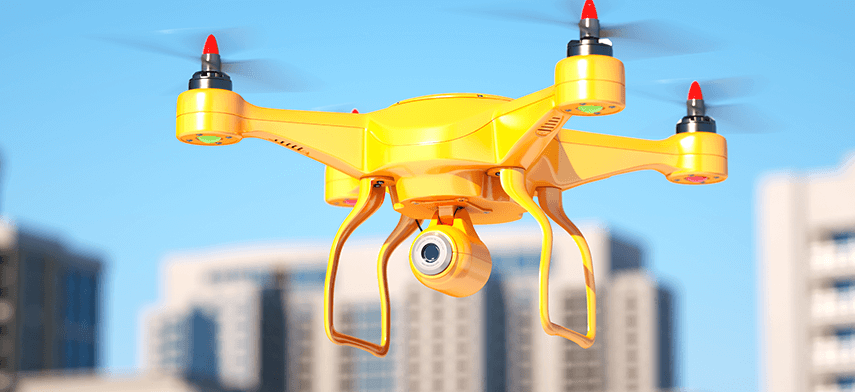
1 Urban First and Last mile
In the supply chain, urban first and last mile are the trickiest steps. The last mile is always the least efficient part, comprising up to 28% of the total cost to move goods. The complex system of delivering goods from centralized warehouses to endpoints is not easy to optimize due to constraints on road transport and infrastructure. Most urban areas these days face traffic congestions more frequently and consistently. The use of drones in logistics has the potential to speed up deliveries and reduce costs that it will change the way deliveries are made worldwide. Imagine deliveries like Amazon Prime Air promises, within 30 mins, as they aren't affected by vehicular traffic.
2 Rural Delivery
The exact opposite of the problem faced by rural areas where the lack of infrastructure makes it difficult for traditional methods of transport to reach. Deliveries in areas like these are made possible by drones.
3 Surveillance of Infrastructure
Like every other industry, logistics also need to monitor their assets for security and safety. BP, a British multinational oil and gas company will routinely use drones to patrol their Alaskan oil fields. This is the first-ever drone powered patrolling operation in the USA. In surveillance, Drones are going to be utilized on two levels for this requirement. Primarily drones are going to be used to survey for damages / lost assets and in the future, they might be equipped to carry out minor repairs as well. Secondarily logistics companies can use their drones to offer services to their customers for asset tracking and monitoring.
4 Intralogistics
Within warehouses, drones are already being utilized for intralogistics systems improvement. PINC, a pioneer in drone logistics, has incorporated UAVs in its yard management and warehouse management solutions. These drones perform inventory management tracking, monitoring, and sorting/counting. Another big logistics company DHL has conducted numerous studies on drones to improve their warehouse management systems with the successful implementation of the tech in their distribution centers. Put simply, any task that requires manual handling of goods for the simple task of transportation, to routine maintenance supervision has been reliably shown in pockets to be doable by drones supported by the advances in AI-driven Image recognition technologies powered by cloud computing clusters.
Conclusion
Even with the regulatory restrictions, the future of drones in logistics is bright. The progress since the conceptualization by Amazon to use drones in their logistics operations has been leaps and bounds and more research and experimentation is going to bring about successful enhancement to this technology in the field of logistics. Companies like Google and Facebook experimenting with drones on their operations, open doors to many more following suit.
A few years ago, Audi made a parody ad with autonomous drones being featured as a nuisance to humans yet the current scenarios are far from that representation. Drones have proven to be a valuable innovation and asset for many industries, and positively changing and impacting the logistics one right through its core. The efficiency of drones and the domains they are becoming relevant in will grow over time, and with constant innovations in drone technology, the entire process is bound to become completely accountable and efficient in the near future.
Author's Bio

